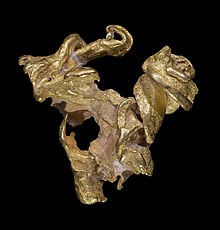
Back Meuih ACE Goud Afrikaans Gold ALS Алтын ALT ወርቅ Amharic Oro AN Gold ANG सोना ANP ذهب Arabic ܕܗܒܐ ARC



Gold is a soft, dense, yellow metal. It is a chemical element. Its chemical symbol is Au. Its atomic number is 79. As a precious metal, it has been used for many thousands of years by people all over the world, for jewelry, and as money. Gold is important because it is rare, but also easier to use than other rare metals. It is also used to repair and replace teeth and in electronic equipment such as computers. The color of this metal is also called gold.
Mining methods for gold are similar to other metals. Gold is so valued that the discovery of a new place to mine has sometimes caused a gold rush. The deepest workplaces for miners in the world are in South African gold mines.
Often, gold is found as a native metal. This means it is not part of an ore, and does not need smelting. It may be in large, pure nuggets but more often must be separated from other minerals and soil.
Most of the gold on Earth is deep inside the Earth's core because it is dense. Nearly all discovered gold was deposited on the surface by meteorites.